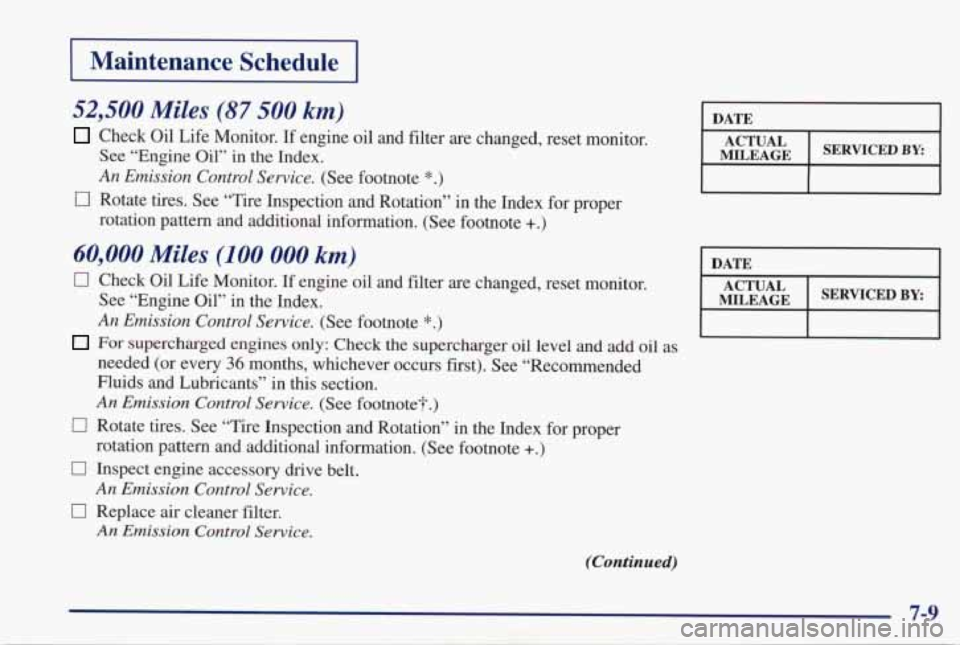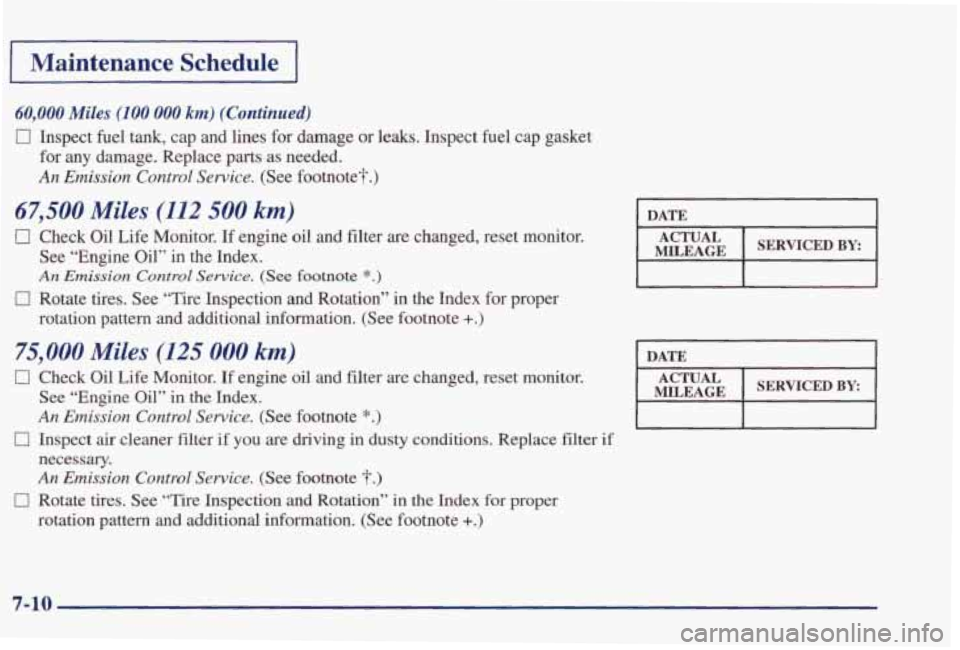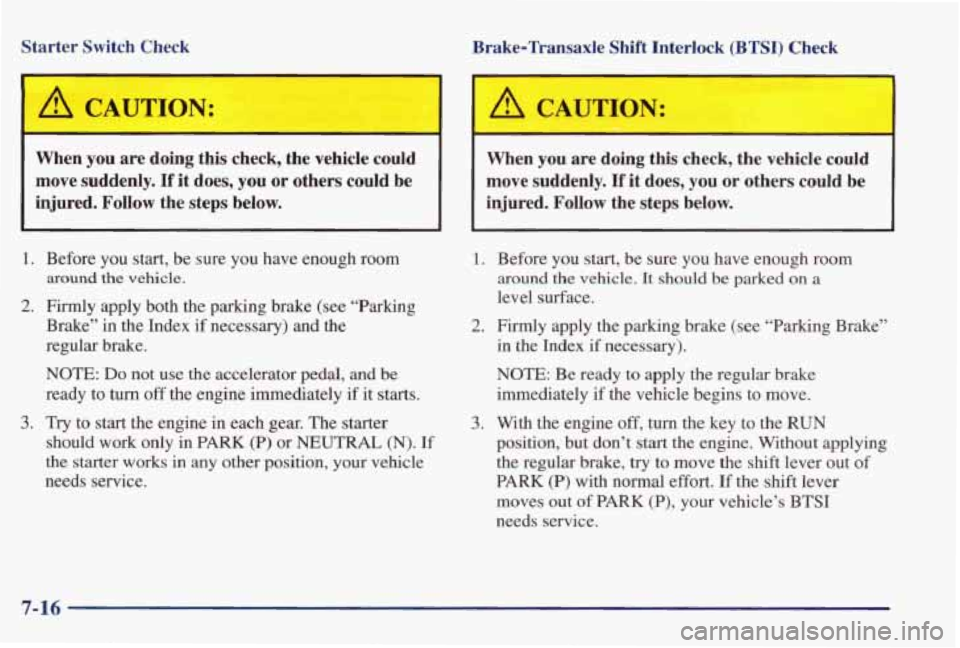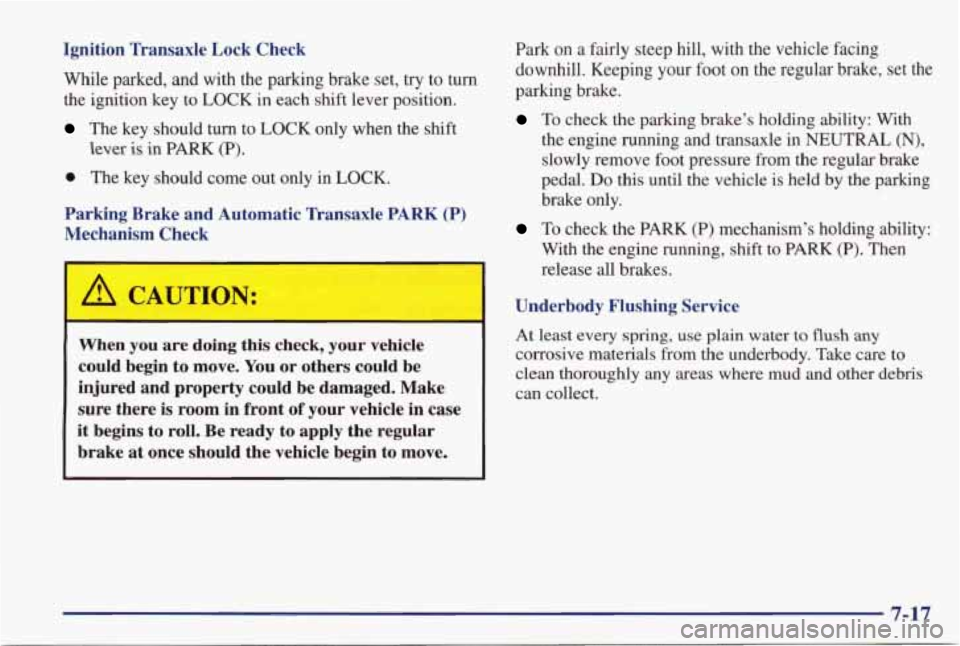1998 PONTIAC GRAND PRIX check engine
[x] Cancel search: check enginePage 354 of 402

I Maintenance Schedule I
52,500 Miles (87 500 km)
Check Oil Life Monitor. If engine oil and filter are changed, reset monitor.
See “Engine Oil” in
the Index.
An Emission Control Service. (See footnote *.)
0 Rotate tires. See “Tire Inspection and Rotation’’ in th\
e Index for proper
rotation pattern and additional information. (See footnote
+.)
60,000 Miles (100 000 km)
I DATE -1
SERVICED BY:
DATE I
0 Check Oil Life Monitor. If engine oil and filter are changed, reset monitor.
See “Engine Oil” in the Index.
An Emission Control Service. (See footnote *.)
For supercharged engines only: Check the supercharger oil level and add oil as
needed (or every 36 months, whichever occurs first). See “Recommended
Fluids and Lubricants” in this section.
An Emission Control Sewice. (See footnote?.)
0 Rotate tires. See “Tire Inspection and Rotation” in the Index for proper
rotation pattern and additional information. (See footnote
+.)
0 Inspect engine accessory drive belt.
0 Replace air cleaner filter.
An Emission Control Service.
An Emission Control Service.
(Continued)
Page 355 of 402

I Maintenance Schedule I
60,000 Miles (100 000 km) (Continued)
0 Inspect fuel tank, cap and lines for damage or leaks. Inspect fuel cap gasket
for any damage. Replace parts as needed.
An Emission Control Service. (See footnote”f)
67,500 Miles (112 500 km)
0 Check Oil Life Monitor. If engine oil and filter are changed, reset monitor.
See “Engine Oil” in the Index.
An Emission Control Sewice. (See footnote *.)
rotation pattern and additional information. (See footnote +.)
0 Rotate tires. See “Tire Inspection and Rotation” in the Index for proper
DATE 1
75,000 Miles (125 000 km)
0 Check Oil Life Monitor. If engine oil and filter are changed, reset monitor.
See “Engine Oil” in the Index.
An Emission Control Service. (See footnote *.)
0 Inspect air cleaner filter if you are driving in dusty conditions. Replace filter if
necessary.
An Emission Control Service. (See footnote “f)
rotation pattern and additional information. (See footnote +.)
0 Rotate tires. See “Tire Inspection and Rotation” in the Index for proper
7-10
Page 356 of 402

I Maintenance Schedule I
82,500 Miles (137 500 km)
0 Check Oil Life Monitor. If engine oil and filter are changed, reset monitor.
See “Engine Oil” in the Index.
An Emission Control Service. (See footnote *.)
rotation pattern and additional information. (See footnote +.)
0 Rotate tires. See “Tire Inspection and Rotation” in the Index for proper
90,000 Miles (150 000 km)
0 Check Oil Life Monitor. If engine oil and filter are changed, reset monitor.
See “Engine Oil” in the Index.
An Emission Control Service. (See footnote *.)
An Emission Control Service.
for any damage. Replace parts as needed.
An Emission Control Service. (See footnote?.)
0 For supercharged engines only: Check the supercharger oil level \
and add oil as
needed (or every
36 months, whichever occurs first). See “Recommended
Fluids and Lubricants” in this section.
An Emission Control Service. (See footnote”f)
rotation pattern and additional information. (See footnote
+.)
Replace air cleaner filter.
0 Inspect fuel tank, cap and lines for damage or leaks. Inspect fuel cap gasket
Rotate tires. See “Tire Inspection and Rotation” in the Index for proper
I DATE I
SERVICED BY:
I DATE I
Page 357 of 402

I Maintenance Schedule I
97,500 Miles (162 500 km)
0 Check Oil Life Monitor. If engine oil and filter are changed, reset monitor.
See “Engine Oil” in the Index.
An Emission Control Service. (See footnote *.)
rotation pattern and additional information. (See footnote +.)
0 Rotate tires. See “Tire Inspection and Rotation” in the Index for proper
100,000 Miles (1 66 000 km)
0 Inspect spark plug wires.
An Emission Control Service.
0 Replace spark plugs.
An Emission Control Service.
0 Change automatic transaxle fluid and filter if the vehicle is mainly driven
under one or more of
these conditions:
- In heavy city traffic where the outside temperature regularly reach\
es
90°F (32°C) or higher.
- In hilly or mountainous terrain.
- When doing frequent trailer towing.
- Uses such as found in taxi, police or delivery service.
Ifyou do not use your vehicle under any of these conditions, the fluid and
filter do not require changing.
DATE I
DATE I
7-12
Page 359 of 402

Part B: Owner Checks and Services
Listed below are owner checks and services which should be performed at the intervals specified
to help
ensure the safety, dependability and emission control
performance of your vehicle.
Be sure any necessary repairs are completed at once.
Whenever any fluids or lubricants
are added to your
vehicle, make sure they are the proper ones, as shown in
Part D.
At Each Fuel Fill
It is important for you or a service station attendant to
perjiorm these underhood checks at each fuel fill.
Engine Oil Level Check
Check the engine oil level and add the proper oil if
necessary. See “Engine Oil” in the Index for
further details.
Engine Coolant Level Check
Check the engine coolant level and add DEX-COOL@
coolant mixture if necessary. See “Engine
Coohnt” in
the Index for further details.
Windshield Washer Fluid Level Check
Check the windshield washer fluid level in the
windshield washer tank and add the proper fluid
if
necessary. See “Windshield Washer Fluid” in the Index
for further details.
At Least Once a Month
Tire Inflation Check
Make sure tires are inflated to the correct pressures. See
“Tires” in the Index for further details.
Cassette Deck Service
Clean cassette deck. Cleaning should be done every
50 hours of tape play. See “Audio Systems’’ in the Index
for further details.
7-14
Page 361 of 402

Starter Switch Check
1-
Brake-Transaxle Shift Interlock (BTSI) Check
r-
When you are doing this check, the vehicle could move suddenly.
If it does, you or others could be
injured. Follow the steps below.
A CAUTION:
When you are doing this check, the vehicle could
move suddenly.
If it does, you or others could be
injured. Follow the steps below.
1.
2.
3.
Before you start, be sure you have enough room
around the vehicle.
Firmly apply both the parking brake (see “Parking
Brake” in the Index if necessary) and the
regular brake.
NOTE: Do not use the accelerator pedal, and be
ready to
turn off the engine immediately if it starts.
Try to start the engine in each gear. The starter
should work only
in PARK (P) or NEUTRAL (N). If
the starter works in any other position, your vehicle
needs service.
1. Before you start, be sure you have enough room
around the vehicle. It should be parked on a
level surface.
2. Firmly apply the parking brake (see “Parking Brake”
in the Index if necessary).
NOTE: Be ready to apply the regular brake
immediately if the vehicle begins to move.
3. With the engine off, turn the key to the RUN
position, but don’t start the engine. Without applying
the regular brake,
try to move the shift lever out of
PARK
(P) with normal effort. If the shift lever
moves out
of PARK (P), your vehicle’s BTSI
needs service.
7-16
Page 362 of 402

Ignition Transaxle Lock Check
While parked, and with the parking brake set,
try to turn
the ignition key to LOCK in each shift lever position.
The key should turn to LOCK only when the shift
lever is in PARK (P).
0 The key should come out only in LOCK.
Parking Brake and Automatic Transaxle PARK
(P)
Mechanism Check
1
Park on a fairly steep hill, with the vehicle facing
downhill. Keeping your foot on the regular brake, set the
parking brake.
To check the parking brake’s holding ability: With
the engine running and transaxle in
NEUTRAL (N),
slowly remove foot pressure from the regular brake
pedal. Do this until the vehicle is held by the parking
brake only.
To check the PARK (P) mechanism’s holding ability:
With the engine running, shift to
PARK (P). Then
release
all brakes.
Underbody Flushing Service
At
least every spring, use plain water to flush any
corrosive materials from the underbody. Take care to
clean thoroughly any areas where mud and other debris
When you are doing this check, your vehicle
could begin
to move. You or others could be
injured and property could be damaged. Make
it begins to roll. Be ready to apply the regular
sure there
is room in front of your
vehicle in case can collect.
brake
at once should the vehicle begin to move.
Page 363 of 402

Part C: Periodic Maintenance
Inspections
Listed below are inspections and services which should be
perfunned at least twice a year (for instance, each spring
and
fall). You should let your dealer’s service department
or other qual$ed service center
do these jobs. Make sure
any necessary repairs are completed
at once.
Proper procedures to perform these services may be
found
in a service manual. See “Service and Owner
Publications” in the Index.
Steering, Suspension and Front Drive Axle
Boot
and Seal Inspection
Inspect the front and rear suspension and steering
system for damaged, loose or missing parts, signs of
wear or lack
of lubrication. Inspect the power steering
lines and hoses for proper hook-up, binding, leaks,
cracks, chafing, etc. Clean and then inspect the drive
axle boot seals for damage, tears or leakage. Replace
seals if necessary.
Exhaust System Inspection
Inspect the complete exhaust system. Inspect the body near the exhaust system. Look for broken, damaged,
missing or out-of-position parts
as well as open seams,
holes, loose connections or other conditions which could cause
a heat build-up in the floor pan or could let
exhaust fumes into the vehicle. See “Engine Exhaust’’ in
the Index.
Engine Cooling System Inspection
Inspect the hoses and have them replaced if they are
cracked, swollen or deteriorated. Inspect
all pipes, fittings
and clamps; replace
as needed. Clean the outside of the
radiator and
air conditioning condenser. To help ensure
proper
operation, a pressure test of the cooling system and
pressure cap is recommended at least once a year.
Throttle System Inspection
Inspect the throttle system for interference or binding,
and for damaged
or missing parts. Replace parts as
needed. Replace any components that have high
effort
or excessive wear. Do not lubricate accelerator and
cruise control cables.
Brake System Inspection
Inspect the complete system. Inspect brake lines and
hoses for proper hook-up, binding, leaks, cracks,
chafing, etc. Inspect disc brake pads for wear and rotors
for surface condition. Inspect other brake parts,
including calipers, parking brake, etc. Check parking
brake adjustment. You may need to have your brakes
inspected more often if your driving habits or conditions
result
in frequent braking.
7-18